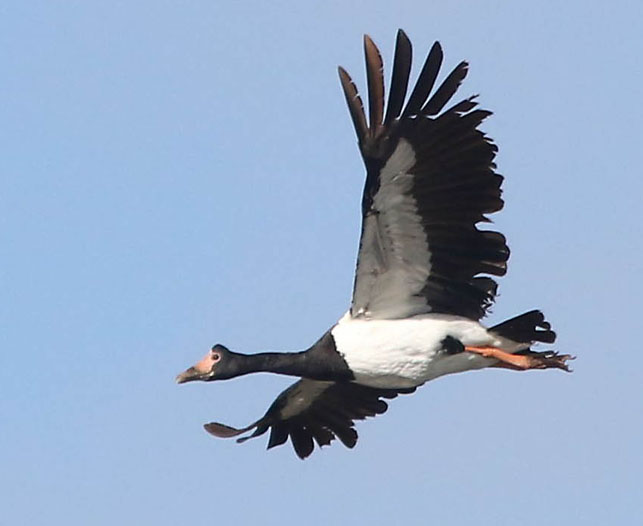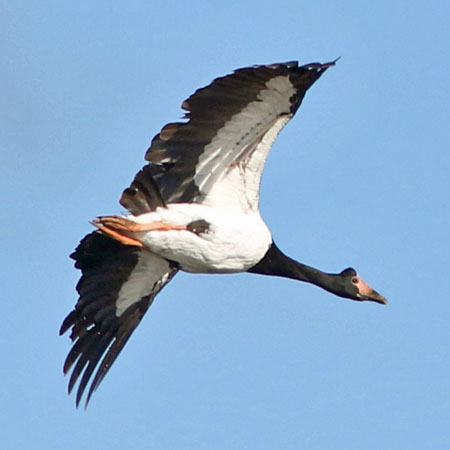
a web page by Don Roberson |
MAGPIE GOOSE Anseranatidae |
||
|
||
 The Magpie Goose (left & below) is found only in swamps and wet grasslands of southern New Guinea and northern Australia. In this respect it fills a niche rather like the one inhabited by screamers [Anhimidae] in the New World. The Magpie Goose (left & below) is found only in swamps and wet grasslands of southern New Guinea and northern Australia. In this respect it fills a niche rather like the one inhabited by screamers [Anhimidae] in the New World. Madge & Burn (1988) summarize: "A unique 'goose' ... that exhibits many features linking the true wildfowl with the terrestrial screamers of South America, the latter resembling gamebirds rather than waterfowl. The long hind toe, slightly-webbed feet, gradual molt progression (thus lacking a flightless period), greatly elongated trachea (in both sexes) and family trios (one male, two female) are all features that isolate this strange bird." Carboneras (1996), in the Handbook of the Birds of the World series, agreed: "Its long legs, bare facial skin and robust bill with a large nail make Magpie Goose a very peculiar species, better adapted to terrestrial habitats than the rest of the Anatidae." Yet Handbook of the Birds of the World did not assign Magpie Goose to family level, although Madge & Burns did. Elevating Magpie Goose to its own family was an innovation with the first molecular studies at the end of the 20th century. Splitting the Magpie-Goose began with Sibley & Ahlquist (1990) and Sibley & Monroe (1990), using DNA-DNA hybridization techniques. However, those authors also placed the whistling-ducks in a separate family ['Dendrocygnidae"], but that assignment has not yet been widely adopted [most world lists consider the whistling-ducks a subfamily]. Instead, molecular research this century have agreed that the Anseranatidae, with only one species, should be at family level status. Studies have shown clear affinities with the other two anseriform families, the Screamers [Anhimidae] and the Ducks, Geese & Swans [Anatidae; e.g., Dickinson 2003, Christidis & Boles 2008]. However, the relative position of these families is not fully resolved, as various arrangements to show relative relationships have receive support in different studies (e.g., Eo et al. 2009, Livezey & Zusi 2007). Whether Magpie Goose is closer the rest of the waterfowl, or if it is closer to the Screamers of South America, is still not determined. |
||
|
||
| In northern Australia and southern New Guinea, family groups and flocks of Magpie Goose move from swamp to wetlands depending on water levels in the dry and wet seasons. John Marchant's photo from northeastern Australia (above) shows at least 50 Magpie Geese in just a portion of one such flock. |
||
| Magpie Goose superficially recalls Spur-winged Goose Plectropterus gambensis of Africa, but only in its large size and pied plumage (Spur-winged Goose is shown below at left; Magpie Goose in flight below at right). Magpie Goose has a white back and a black face and throat, Spur-winged has a black back and white face and throat. Spur-winged also lacks the protuberance on top the bill. Bill knobs on Magpie Geese tend to be larger in males than in females. | ||
|
||
Photos: My photos of Magpie Goose Anserianas semipalmata were at Lake Lake Gallety, near Brisbane, Queensland, Australia, on 3 Sep 2016. John Marchant's photo of a flock of Magpie Goose Anserianas semipalmata was in Hastie Swamp, Queensland, Australia, on 8 Nov 1982. The photo of Spur-winged Goose Plectropterus gambensis was in Ngorongoro Crater, Tanzania, on 11 June 2018 [Great White Pelicans in background]. All photos © Don Roberson; all rights reserved. Bibliographic note: There is no family book but this group is covered in standard waterfowl texts, and the Australian literature that includes this family is reasonably extensively. Magpie Goose is covered in Carboneras (1992) as a subfamily of the Anatidae. Literature cited:
|



